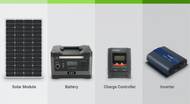INTRODUCTION TO OFF-GRID SOLAR PANEL APPLICATIONS
31st May 2020
Why choose solar panel as a power source?
In today’s world, any economy cannot survive without energy. However, the use of traditional energy sources has also brought us many problems, such as pollution, global warming, etc. Sometimes, it is also not convenient to connect to a utility line if you are in the middle of nowhere. Therefore, renewable energy, especially solar, has become a more popular option for power source.
What is Off-grid Solar Application?
No matter if you are new to solar, or have already been using solar, you might have heard the term “off-grid” quite often.
The term “off-grid” means an independent lifestyle that does not rely on any public utilities that can be electricity, gas, water, and sewer system. In this article, when we say “off-grid”, we are referring to not being connected to the electrical grid in particular.
An off-grid system is a mechanism that can generate power without connecting to any power line or utility provider. An off-grid solar application indicates that the main power source is supported by solar energy.
In this article, we will look into what makes up an off-grid solar system, and what are the functions of each component.

Components of Off-grid Solar Application
The components of the system can vary from case by case and depend on user’s need. But the essential items are:
- Solar module
- Charge controller
- Battery
- Inverter
By absorbing solar radiation through the photovoltaic cells, solar panels generate direct current (DC) energy. With an inverter, the energy can be converted into alternative current (AC).
One solar panel mainly includes toughened glass, EVA, solar cells, back sheet, aluminum alloy frame, silica gel, junction box, cable, and connector.
A common question when it comes to solar panel is whether to choose mono-crystal or poly-crystal cells. The main difference between mono and poly is the efficiency of production and photoelectric conversion. The conversion efficiency for a panel using poly crystalline solar cell is about 18.6%. For mono-crystal silicon panel, the rate is approximately 20.2% - 22.4% or even higher.
The controller plays an important role in terms of regulating the current from the solar panel and the battery. In the meantime, it stops the electricity leaked back to the panel from the battery, when there is not enough power input from the panel (e.g. during night or a cloudy day). It also prevents overcharging of the battery.
Many people may have noticed the different types of charge controller, namely PWM and MPPT. So, what are the differences?
PWM uses the digital output of microprocessor to control the analog circuit. PWM technology is mature, the circuit is simple and reliable, the price is low, but the utilization rate of components is low. The utilization rate of the module is about 70%.
MPPT solar controller refers to the solar controller with the maximum power point tracking function. There is a buck circuit between the module and the battery, and the utilization rate of the module is about 90%.
The main job of an inverter is to convert DC into AC power, the one that you usually have outlets in your home. In other words, you can transfer the power that is stored in your battery (DC power) into your everyday usage, such as TV, computers, fans, and other appliances (AC power). A good inverter will also provide features like overload protection, low battery alarm/shut down and low idle power draw.
Other Components
Mounts, adjustable tilt brackets, and generator can also be part of the system. But whether the user need them is based on the application of the solar system.
In Short
An off-grid photovoltaic system is usually composed of solar panel, controller, inverter, and battery. They generate DC energy and can be directly supplied to the DC load. They can also be connected to inverters to convert DC power to AC power for use by ac load. The remaining power is stored in a battery bank and is used to provide power at night or on cloudy or rainy days. Other common components would include mounts, adjustable tilt brackets and generator.
